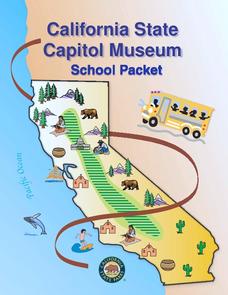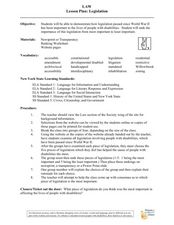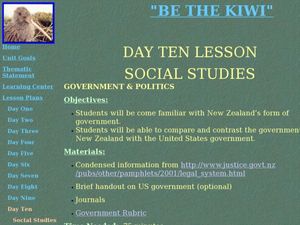Curated OER
Order in the Court
Students identify the branches of government, who leads each branch and its responsibilities. They understand the role that John Marshall played in our government system. They research the role of the Supreme Court.
Curated OER
We the People: An American Government Project
High schoolers identify key representatives in the legislative and executive branches of the Federal and State governments
Curated OER
TE Activity: Pollution Politics
Students examine how a bill becomes a law in the US Congress. They investigate legislation about global warming. They determine the role of engineers as they educate Congress, the public and other government institutions about global...
California State Parks
California State Capitol Museum School Packet
Here is great packet of worksheets to introduce your young learners to the general history of California and basic facts about the Golden State. Topics covered range from state counties, Sacramento, and the capitol to...
Curated OER
Same-Sex Marriage Legalized in New York
Same-sex marriage is the hot topic discussed in this New York Times article. Upper graders read the article and then answer eight comprehension questions. Note: This article is more about the Senate and legislation than about same-sex...
Curated OER
The U.S. Constitution
Young scholars explain the differences between the three branches of government. Using the structure of a democracy, they listen to text about the United States Constitution. They discover how their government affects their lives in...
Curated OER
A Bill Becomes A Law
Students discover how a bill becomes a law. In this Legislative Branch lesson, students simulate a bill making its way through the House and the Senate. Students author their own bills in this simulation.
Curated OER
Follow a Bill!
Students discover how a bill becomes a law. In this Legislative Branch lesson, students watch C-Span coverage of a bill making its way through the House and the Senate. Students use the provided worksheet to chart the progress of the bill.
Curated OER
Twelve Angry Men: Trial by Jury as a Right and as a Political Institution
Learners explore the constitutional guarantee of the right to trial by jury. In this U. S. Constitution lesson, students read or view Twelve Angry Men and respond to discussion questions regarding the jury. Learners examine the...
Curated OER
How the Supreme Court Affects the Lives of Teens
Students describe the structure and function of the United States Supreme Court. They examine and analyze decisions made by the Court. They participate in a debate about recent issues.
Curated OER
US Government: Supreme Court
Students explore the powers of the Supreme Court. In this Judicial Branch lesson, students define vocabulary regarding the branch's responsibilities, take notes on a video regarding the branch, and discuss the powers of the branch in a...
Curated OER
The U. S. Constitution (5)
In this online interactive American history worksheet, students answer 17 fill in the blank questions regarding the U. S. Constitution. Students may submit their answers to be scored.
Curated OER
Leaders in the Judicial Branch
Students examine the leadership roles and qualities of members of the judicial branch in public life. They view and discuss video clips from a federal judge and two Supreme Court judges.
Curated OER
Executive Branch of the U.S. Government
Fourth graders create a K-W-L chart of what they know about the executive branch of government. They access the Internet to research a specific level of government. They create a PowerPoint presentation with a minimum of eight slides.
Curated OER
Executive Government: Executive Decision Making
Learners explore executive decision making in the federal Cabinet. They are able to explain the need for executive decisions. Students explore how executive decisions are implemented through government departments.
Curated OER
Who Represents You? My Government in Pennsylvania Project
In this representation in government learning exercise students answer questions about who represents their state in each office and level of government.
Curated OER
Six Day War
Learn about the diverse perspectives involved in the Six Day War by having learners examine and annotate presidential speeches given by the three nations—Egypt, Israel, and the United States—at the heart of the conflict and producing...
Curated OER
Constitutional Acts (Chapter 3)
Help your students review constitutional acts in this review worksheet, which could also be used as a class quiz. Five matching questions and five multiple choice questions address checks and balances, the powers of the Senate and House,...
Curated OER
Legislation
Students rank the legislation of disabilities since World War I and write their rationale for the ranking. In this legislation of disabilities lesson plan, students do this for 5 legislations that have been passed.
Curated OER
Mock Congress
Students simulate the legislative process of law-making by assuming different roles. They investigate the process by writing a bill on any subject of his/her own choice
Curated OER
Introductions to Elections and Government
Eighth graders explore the process of election. In this elections and government lesson, 8th graders complete a K-W-L chart and research the Internet to complete a fact sheet and report on to their peers. This lesson is day two of a two...
Curated OER
iCivics: State Government
Students explore the role of state government. In this civics lesson, students play an online game that requires them to consider the needs of state residents and the structure of state government.
Curated OER
Be the Kiwi: Government and Politics in New Zealand
Students examine the structure of government in New Zealand. In this government activity, students listen their instructor present information about the government in New Zealand then create diagrams that compare its structure to the...
Curated OER
Leaders in the Legislative Branch
Students read case studies about the leaders in the legislative branch of government. After reading the studies, they discover how the leaders have compromised on issues to best serve their states. They answer discussion questions and...























